Are you wondering how to properly brush your teeth? Brushing our teeth is something most of us have done for as long as we can remember, but often without much thought as to the correct way to do it.
Well, it’s great that you’re giving it some thought now! Keeping your teeth clean is a very important part of maintaining good overall oral health.
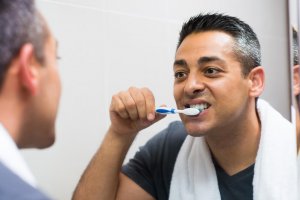

This detailed guide has all you need to know about how to clean your teeth. We answer some common questions including:
- How long to brush teeth
- How often should you brush your teeth and at what times of day
- Whether to floss before or after brushing teeth
- Whether to rinse after brushing
- How to choose the best products for your oral hygiene routine
- Tooth brushing mistakes to avoid
You might be surprised to find that you didn’t know how to brush teeth quite right all these years, but we hope this guide helps you learn how to clean your teeth at home, so you can always feel that after-the-dentist clean.
Common questions about how to properly brush teeth
Did you know that just 53% of people worldwide brush their teeth twice a day? If that sounds like you, you’re in the right place.
We’re going to begin with some specific questions that people often have about the correct way to brush teeth. Then, you’ll find detailed step-by-step instructions on how to brush your teeth, followed by some more tips for keeping your teeth and mouth healthy.
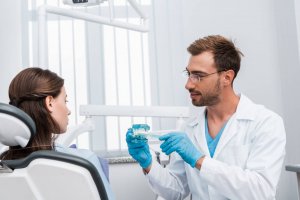

Please note that this guide focuses mainly on teeth brushing for adults. Although much of this information also applies to children, we recommend you read our guide to children’s oral health if you want to check how to brush your child’s teeth.
Also note that your dentist may give you slightly different advice according to your own oral health. Of course, you should always follow what your dentist recommends.
Ok, so let’s take a look at some FAQs about brushing teeth.
How often should you brush your teeth?
You should brush your teeth at least twice a day. Some people like to brush three times a day, or even more. While it is possible to over-brush your teeth, this is more likely to result from a bad technique than brushing too often.
One thing’s for sure: Brushing teeth just once a day is not enough to keep them clean. Despite this, 30% of Americans admit to only brushing once a day, according to the Delta Dental Oral Health and Well-Being Survey. Once-a-day brushing gives the bacteria too long to eat away at the surface of your teeth, meaning an increased likelihood of cavities.
When should you brush your teeth?
Brush your teeth before going to bed, and at least one other time during the day. For most people, this will be in the morning. It’s fine to brush more often than this. Provided you know how to brush your teeth correctly.
It’s important to have clean teeth before bedtime because while you’re asleep, there is less saliva in your mouth to fight any bacteria that remain. However, 70% of people who only brush once a day say they do so in the morning, rather than the evening.
You might be surprised to hear that the best time to brush your teeth is not immediately after eating – especially if you’ve had very acidic or sugary food or drink. This is because sugar and acid weaken tooth enamel, and you may damage your teeth by brushing them when they have just been exposed. Instead, rinse your mouth with water straight after eating and brush your teeth 30-60 minutes later.
Should you brush your teeth before or after breakfast?
Do you brush your teeth before or after breakfast? It turns out that as long as you are brushing twice a day, it doesn’t much matter whether you brush before or after breakfast.
However, as mentioned above, if you are thinking about brushing after breakfast, you might want to consider waiting a bit after you eat before brushing. This is because acidic food and drinks weaken tooth enamel, and so if you brush too soon, you might end up removing some of that precious enamel.
For how long should you brush your teeth?
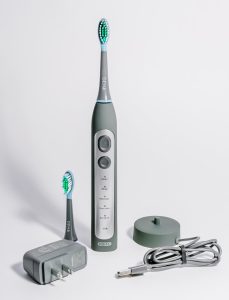

Two to three minutes is the recommended teeth brushing time. Any less than this and you won’t have time to clean every surface of every tooth properly, but you can possibly over-brush. Brushing your teeth for longer isn’t necessarily a good thing, as you might cause damage to your teeth and gums from over-brushing.
But it’s really important to concentrate on what you’re doing during those few minutes. Develop a brushing routine – like the one given below – and stick to the same pattern every day. Don’t let yourself get distracted, otherwise, you could spend five minutes brushing the same few teeth and not even realize it.
If this happens to you, you might want to consider an electric toothbrush with a timer, like this sonic brush from CariPRO. It uses 40,000 sonic vibrations per minute to remove plaque from teeth. Plus it’s got five different cleaning modes, one of which helps with extra whitening! Read more about CariPRO Ultrasonic toothbrush in our review, or click the button below to try CariPRO for yourself.
Should you floss before or after brushing?
According to the American Dental Association, it doesn’t matter if you floss before or after brushing, just as long as you do it. In fact, the ADA doesn’t specify a preferred time of day, either.
They simply recommend that you choose a time when you don’t mind spending a couple of extra minutes flossing and that different times of day work better for different people. For example, if you know you’ll be too tired before going to bed to bother with flossing, then try to do it in the morning, or at lunchtime.
Either way, the important thing is that you do floss regularly. Most Americans don’t. Our flossing guide explains how to floss your teeth properly and why it’s so important.
Should you rinse after brushing your teeth?
Although the American Dental Association hasn’t stated a strong opinion about this, international studies suggest that it’s better to not rinse or to just rinse with a little bit of water after brushing.
The studies, like one done by the International Dental Journal in 2013, cited by the University of California Berkely, provides some evidence that if you rinse after brushing your teeth, you wash away the fluoride in your toothpaste which is there to help fight decay and strengthen your teeth. Spit but don’t rinse, and the fluoride stays on your teeth for longer.
Should you brush your tongue?
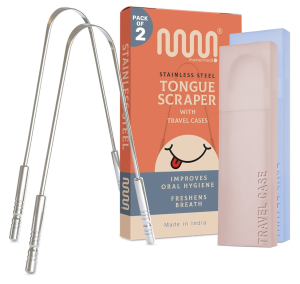

Cleaning your tongue helps combat bad breath and reduce bacteria in your mouth. You can clean your tongue using your toothbrush or a tongue scraper as part of your daily teeth brushing routine.
Should you brush your gums?
No. The part most at risk is the gum line, where your gums meet your teeth. Brush teeth at a 45-degree angle, to clean the gum line and keep your gums healthy.
You might need to visit the hygienist for a scale and polish (routine dental cleaning) to remove any tartar that’s already built up on your teeth, otherwise, you risk developing gum disease.
Is it OK to chew gum instead of brushing your teeth?
Chewing sugar-free gum after eating can help prevent cavities, but it’s not a substitute for brushing. Chewing gum can help dislodge food particles and produce saliva. This naturally fights acids that can damage your teeth.
Remember to choose a sugar-free variety, otherwise, you’re just coating your teeth with even more damaging sugar. And use it in addition to – not instead of – twice-daily brushing.
What happens when you don’t brush your teeth?
“Nothing good,” according to Matthew Messina, dentist and ADA spokesperson in an interview with USA Today. Despite the rather blithe answer, he is, of course, right.
While forgetting to brush your teeth once in a while isn’t a big deal, if you continue to do so, you’ll encounter problems like plaque and tartar build-up and bad breath.
And then these problems can turn into tooth decay, loss of teeth and gum disease! So, brush your teeth!
Can you brush your teeth too much?
Just like with anything, too much brushing isn’t necessarily a good thing. If you brush your teeth too much, you may wear down the enamel on your teeth. This, in turn, can cause sensitive teeth, and can actually make your teeth appear yellower because the yellow dentin behind your enamel will be more visible. Overbrushing can also lead to gum recession in some cases.
Can you brush your teeth with baking soda?
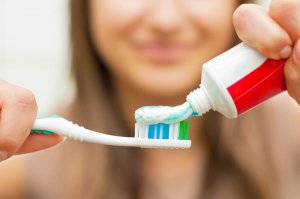

Making a paste out of baking soda and water, and then adding oil for flavor and some salt, or adding a bit of baking soda to your toothpaste is a widely recognized way to naturally whiten your teeth.
How to brush your teeth properly: step-by-step guide
We’ve established that you should brush at least twice a day, one of those times before you go to bed, for two to three minutes each time. Here’s what to do in those few minutes as you brush your teeth:
Use the correct amount of fluoride toothpaste
Use a soft-bristled toothbrush that fits easily in your mouth, so you can reach everywhere you need to brush.
The toothpaste doesn’t need to cover the brush head as you see in many toothpaste ads. A pea-sized amount is enough for anyone over three years of age. These are the amounts of toothpaste recommended by the ADA according to age group:
| Age | Amount to use |
| Children under 3 | A smear (size of a grain of rice) |
| Children 3-6 | A pea-sized amount |
| Children over 6 and adults | A pea-sized amount |
Although the ADA hasn’t recently specified the optimal concentration of fluoride in toothpaste per age group, internationally it is recommended that 1,000ppm be used up to age six, and 1,350–1,500ppm thereafter.
Angle the brush at 45 degrees
When brushing the sides of your teeth, tilt your brush 45 degrees so that the bristles can reach inside the small gap between your teeth and gums. If plaque builds up in this pocket, it can lead to gum disease.
Brush teeth gently with small circular motions
Many people brush their teeth using a back-and-forward scrubbing motion, but small circular movements are actually the proper way to brush teeth, as they are more effective and less damaging.
You also don’t need to exert a lot of pressure nor scrub as hard as you can. Gentle pressure is enough to loosen plaque, and if you brush too hard you might make your gums bleed. Many electric toothbrushes come with a pressure sensor which alerts you if you’re brushing your teeth too forcefully.
Brush every surface of every tooth
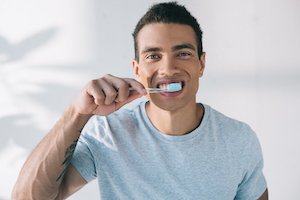

The order in which you brush your teeth doesn’t matter, but doing it the same way every time can help ensure you don’t miss any surfaces. This is one example of how you can brush your teeth:
- Begin at the back of your mouth, top left or top right
- Work your way around the outer surface of each tooth, brushing each one in small circular motions for a few seconds
- Turn your brush to the inner surface and work your way around the top again
- Brush the biting surface of your top molars and the back surface of your rear teeth
- Turn the brush vertically and use a downwards motion to brush the back of your front teeth a few times
- Repeat for the bottom teeth
- After cleaning your teeth, brush or scrape your tongue a few times
Another way is to break your mouth into four quadrants and spend 30 seconds on each one, brushing the inner, outer and biting surfaces as you go.
Spit but don’t rinse
Remember, if you rinse with water or mouthwash straight after brushing your teeth, the ingredients in your toothpaste get diluted or washed away. If you choose to use mouthwash then wait a while after brushing, or use it to freshen up at other times of the day when brushing isn’t possible.
Clean between teeth once a day
You don’t need to do this every time you brush, but cleaning between your teeth daily will help keep plaque at bay. You can use string floss, interdental brushes or a water flosser to do this.
Video showing how to brush teeth
This video sums up the best way to brush teeth:
Other considerations
How to brush your teeth with braces
When brushing your teeth with braces, you’ll want to make sure you follow the same technique as you would without braces, but with some extra steps. In addition to the proper steps mentioned above, you should place the toothbrush on the brackets and angle down, brushing in small circles like normal. Then, with the toothbrush still positioned on top of the brackets, angle up and do the same thing.
How to brush your teeth without a toothbrush
Let’s be clear, you should definitely use a toothbrush to properly brush your teeth. However, most of us have had the experience of spending the night away from home and forgetting to bring a toothbrush. When this situation inevitably happens to you, you can wrap a piece of a wet paper towel around your index finger, dab some toothpaste on it and use the same brushing motions as you would with your toothbrush.
One of the most important things you can do for the health of your child’s teeth is daily tooth brushing. Don’t ever underestimate the power of this simple, two-minute act for oral hygiene efforts. Oral health starts with a commitment to regular tooth brushing and flossing. The American Dental Association recommends the following:
- Engage in tooth brushing twice a day with a soft-bristled brush. The size and shape of a toothbrush should accommodate the size of your child’s mouth allowing you to reach all areas easily. Soft silicone brushes are becoming increasingly popular.
- Use the right amount of toothpaste: Rice-sized amount for babies; pea-sized amount for toddlers.
- Replace toothbrushes every three or four months–sooner if bristles are frayed. A worn-out toothbrush isn’t a good tool for cleaning teeth.
- Check the label. Before you buy, make sure you are using an ADA-accepted fluoride toothpaste.
- Parents should help supervise children when they brush their teeth until age 11.
Dr. Catalina Botero, Li’l Sunshine Smiles Dentistry
Choosing the right products to brush teeth
Now that you know how to brush your teeth, you might be wondering which products are best to use. Here are some things to consider, but you’ll find more information in our more detailed guides on each of these topics.
Toothbrush
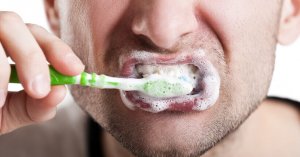

You might think that scrubbing vigorously with a hard-bristled toothbrush will help remove more plaque, but in fact, this is not the proper way to brush teeth, and it can be damaging to your teeth and gums. Soft or medium bristles should do the job just fine. Choose a small brush head that lets you reach your back teeth easily.
An electric toothbrush may help you brush your teeth more effectively. Read about why this is, how to choose the best one for you, and popular brands like Sonicare and Oral-B in our best electric toothbrush guide, or have a look at the best toothbrushes for whitening.
Or, read about the best manual toothbrushes around if you prefer to keep it simple. And if you’re looking for a way to reduce your carbon footprint and care for the environment, you may even be interested in eco-friendly options like bamboo toothbrushes.
You should replace your toothbrush or brush head every three months, or sooner if you notice the bristles are splaying (this could be a sign you’re brushing too hard). Using an old, frayed brush may damage your enamel.
Toothpaste
Using a toothpaste that contains fluoride (at least 1,000 ppm for adults and children) helps you fight decay as you brush. Choose a brand and flavor that you enjoy using, as this will make you more likely to keep up regular brushing. Read more about choosing the best toothpaste for children and the best toothpaste for adults in our full guides.
Natural toothpastes with and without fluoride are available for purchase, and you can even make your own if you prefer. Read more about the options in our natural toothpaste guide.
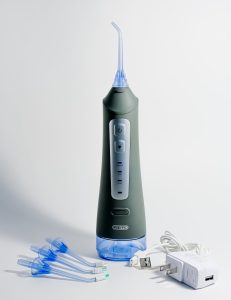

Floss
Brushing teeth only cleans three out of the five surfaces, so it’s important to clean between them as well. If you don’t like using traditional dental floss, or if you have braces, a water flosser can make the job a lot easier.
If you’re serious about your oral hygiene, and a water flosser interests you, you may want to try the cariPRO Cordless Water Flosser.
This flosser comes with 4 specialty floss tips including standard, ortho, restorations and gum health. It also features an ergonomic design with a soft touch grip.
A 60-day trial means that if you don’t like it after three months, you can get a full refund. Get your cariPRO now for a discounted price.
Mouthwash
Mouthwash doesn’t just freshen your breath; choose one that contains fluoride and it’ll also work to prevent tooth decay. However, it’s unclear if you should use it straight after brushing because it rinses off the fluoride left from your toothpaste. This goes for fluoride mouthwashes as well.
To read more about how to use mouthwash correctly and the various brands, view our guide to the best mouthwashes for different oral health problems.
Plaque disclosing tablets
If you want to see whether you’re doing a good job of brushing, pick up some plaque disclosing tablets. These chewable tablets dye any plaque in your mouth so you can clearly see what’s left behind after you brush. Then, you can work on improving how you brush your teeth.
Other ways to care for your teeth
Knowing how to clean your teeth properly is only part of the picture when it comes to maintaining good oral health. Here are some other things you can do to make sure your new teeth brushing efforts are not going to waste.
Watch what you eat
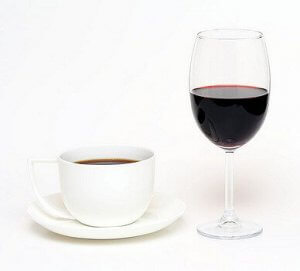

You know that eating sugar is bad for your teeth, but there’s a lot more to it than that. Acidic foods and drinks like vinegar, pickles, fruit juice, wine and soft drinks can be just as damaging. Plus, a lot of “healthy” snacks like dried fruits, cereal bars and yogurts contain more sugar than you might realize.
The damage increases if you snack regularly on these culprits throughout the day, rather than limiting them to mealtimes. Constant grazing means your teeth don’t get a break from the sugar and acid which wear away enamel.
Not only does this result in greater risk of tooth decay; you may get yellow teeth or sensitive teeth because of thinning enamel.
Have regular dental checkups
Even if you know how to brush your teeth properly and follow a good oral hygiene routine every day, dental problems can still occur. Having regular checkups lets your dentist catch these early on and means treatment should be less invasive (and less expensive) than if you leave the problem to develop.
Your dentist will use special tools like manual scrapers, or ultrasonic dental cleaners to get rid of plaque and tartar buildup.
Your dentist will also give you advice on the best way to brush your teeth and care for your overall oral health, so don’t be tempted to skip your checkups!
Conclusion
We hope you have found these oral hygiene instructions useful and that you now understand how to brush teeth properly. Perhaps it’s even highlighted some things you were doing wrong?
Remember, keeping your teeth clean and healthy involves:
- Brushing at least twice a day, for two minutes at a time
- Using a soft-bristled toothbrush and a fluoride toothpaste
- Not rinsing after you brush (even with mouthwash)
- Not brushing teeth straight after eating acidic or sugary foods and drinks
- Avoiding snacking on sugary and acidic foods and drinks
- Flossing daily
- Visiting your dentist regularly
If you’re still unsure about how to clean your teeth properly or you have any other concerns, speak to your dentist at your next visit.
Oral Health Foundation: Diet and my teeth. Consulted 26th August 2024.
Oral Health Foundation: Caring for my teeth and gums. Consulted 26th August 2024.
Mayoclinic.org: When and how often should you brush your teeth? Consulted 17th September 2024.
MouthHealthy: Flossing. Consulted 17th September 2024.
ADA.org: Fluoride: Topical and Systemic Supplements. Consulted 17th September 2024.
USA Today: What would happen if you didn’t brush your teeth for a year? Consulted 17th September 2024.
Sunstar: Global Healthy Thinking Report. Consulted 11th September 2024.
Oral Health Foundation: Diet and my teeth. Consulted 26th August 2024.
Oral Health Foundation: Caring for my teeth and gums. Consulted 26th August 2024.
Mayoclinic.org: When and how often should you brush your teeth? Consulted 17th September 2024.
MouthHealthy: Flossing. Consulted 17th September 2024.
ADA.org: Fluoride: Topical and Systemic Supplements. Consulted 17th September 2024.
USA Today: What would happen if you didn’t brush your teeth for a year? Consulted 17th September 2024.
Sunstar: Global Healthy Thinking Report. Consulted 11th September 2024.




